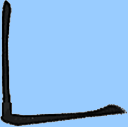The final group of secondary strokes has 2 strokes in it. In the first group of 3 right arm strokes, the elbow is straight. In the second group, the elbow bends 45o. In this third group, the elbow bends 90o. With a 90o angle, there are only 2 such strokes; there is no diagonal stroke. For both of these strokes, the upper arm is either vertical or horizontal, and the forearm is the opposite. The wrist is straight, the palm is open and the fingers are flat.
The first of the 2 strokes with a bend corresponds to the vertical stroke, and is called 豎折 (shùzhé) in Chinese.
The upper arm position for this stroke is similar to the upper arm arm position for the vertical stroke. The upper arm extends vertically downward alongside the body. However, instead of the elbow being straight, it is bent toward the right at a 90o angle, such that the forearm extends horizontally toward the right. The wrist is in line with the forearm, the palm is open, and the fingers are flat.
As an example, this stroke appears in the character for medical, 医.

